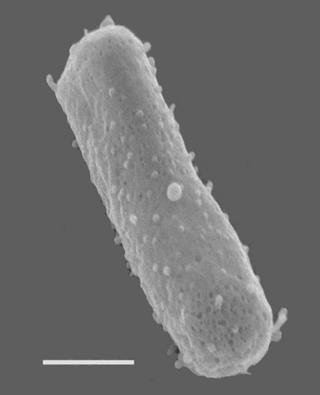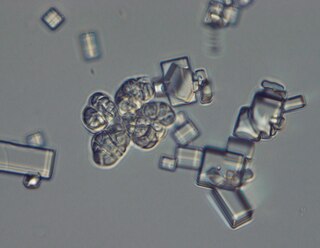Related Research Articles
Halotolerance is the adaptation of living organisms to conditions of high salinity. Halotolerant species tend to live in areas such as hypersaline lakes, coastal dunes, saline deserts, salt marshes, and inland salt seas and springs. Halophiles are organisms that live in highly saline environments, and require the salinity to survive, while halotolerant organisms can grow under saline conditions, but do not require elevated concentrations of salt for growth. Halophytes are salt-tolerant higher plants. Halotolerant microorganisms are of considerable biotechnological interest.

Halobacterium is a genus in the family Halobacteriaceae.
Halobacteriaceae is a family in the order Halobacteriales and the domain Archaea. Halobacteriaceae represent a large part of halophilic Archaea, along with members in two other methanogenic families, Methanosarcinaceae and Methanocalculaceae. The family consists of many diverse genera that can survive extreme environmental niches. Most commonly, Halobacteriaceae are found in hypersaline lakes and can even tolerate sites polluted by heavy metals. They include neutrophiles, acidophiles, alkaliphiles, and there have even been psychrotolerant species discovered. Some members have been known to live aerobically, as well as anaerobically, and they come in many different morphologies. These diverse morphologies include rods in genus Halobacterium, cocci in Halococcus, flattened discs or cups in Haloferax, and other shapes ranging from flattened triangles in Haloarcula to squares in Haloquadratum, and Natronorubrum. Most species of Halobacteriaceae are best known for their high salt tolerance and red-pink pigmented members, but there are also non-pigmented species and those that require moderate salt conditions. Some species of Halobacteriaceae have been shown to exhibit phosphorus solubilizing activities that contribute to phosphorus cycling in hypersaline environments. Techniques such as 16S rRNA analysis and DNA-DNA hybridization have been major contributors to taxonomic classification in Halobacteriaceae, partly due to the difficulty in culturing halophilic Archaea.

Halobacteriales are an order of the Halobacteria, found in water saturated or nearly saturated with salt. They are also called halophiles, though this name is also used for other organisms which live in somewhat less concentrated salt water. They are common in most environments where large amounts of salt, moisture, and organic material are available. Large blooms appear reddish, from the pigment bacteriorhodopsin. This pigment is used to absorb light, which provides energy to create ATP. Halobacteria also possess a second pigment, halorhodopsin, which pumps in chloride ions in response to photons, creating a voltage gradient and assisting in the production of energy from light. The process is unrelated to other forms of photosynthesis involving electron transport; however, and halobacteria are incapable of fixing carbon from carbon dioxide.

Haloarchaea are a class of the Euryarchaeota, found in water saturated or nearly saturated with salt. Halobacteria are now recognized as archaea rather than bacteria and are one of the largest groups. The name 'halobacteria' was assigned to this group of organisms before the existence of the domain Archaea was realized, and while valid according to taxonomic rules, should be updated. Halophilic archaea are generally referred to as haloarchaea to distinguish them from halophilic bacteria.

Halobacterium salinarum, formerly known as Halobacterium cutirubrum or Halobacterium halobium, is an extremely halophilic marine obligate aerobic archaeon. Despite its name, this is not a bacterium, but a member of the domain Archaea. It is found in salted fish, hides, hypersaline lakes, and salterns. As these salterns reach the minimum salinity limits for extreme halophiles, their waters become purple or reddish color due to the high densities of halophilic Archaea. H. salinarum has also been found in high-salt food such as salt pork, marine fish, and sausages. The ability of H. salinarum to survive at such high salt concentrations has led to its classification as an extremophile.

Haloarcula is a genus of extreme halophilic Archaea in the class of Halobactaria.

Haloquadratum is a genus of archaean, belonging to the family Haloferacaceae. The first species to be identified in this group, Haloquadratum walsbyi, is unusual in that its cells are shaped like square, flat boxes.
Halorubrum is a genus in the family Halorubraceae. Halorubrum species areusually halophilic and can be found in waters with high salt concentration such as the Dead Sea or Lake Zabuye.
In taxonomy, Natrialba is a genus of the Natrialbaceae. The genus consists of many diverse species that can survive extreme environmental niches, especially they are capable to live in the waters saturated or nearly saturated with salt (halophiles). They have certain adaptations to live within their salty environments. For example, their cellular machinery is adapted to high salt concentrations by having charged amino acids on their surfaces, allowing the cell to keep its water molecules around these components. The osmotic pressure and these amino acids help to control the amount of salt within the cell.
Halocins are bacteriocins produced by halophilic Archaea and a type of archaeocin.
Nanohaloarchaea is a clade of diminutive archaea with small genomes and limited metabolic capabilities, belonging to the DPANN archaea. They are ubiquitous in hypersaline habitats, which they share with the extremely halophilic haloarchaea.

Wallemia ichthyophaga is one of the three species of fungi in the genus Wallemia, which in turn is the only genus of the class Wallemiomycetes. The phylogenetic origin of the lineage was placed to various parts of Basidiomycota, but according to the analysis of larger datasets it is a (495-million-years-old) sister group of Agaricomycotina. Although initially believed to be asexual, population genomics found evidence of recombination between strains and a mating type locus was identified in all sequenced genomes of the species.

Haloferax volcanii is a species of organism in the genus Haloferax in the Archaea.

Haloquadratum walsbyi is of the genus Haloquadratum, within the archaea domain known for its square halophilic nature. First discovered in a brine pool in the Sinai peninsula of Egypt, H. walsbyi is noted for its flat, square-shaped cells, and its unusual ability to survive in aqueous environments with high concentrations of sodium chloride and magnesium chloride. The species' genus name Haloquadratum translates from Greek and Latin as "salt square". This archaean is also commonly referred to as "Walsby's Square Bacterium" because of its identifying square shape which makes it unique. In accordance with its name, Haloquadratum walsbyi are most abundantly observed in salty environments.
Halobacterium noricense is a halophilic, rod-shaped microorganism that thrives in environments with salt levels near saturation. Despite the implication of the name, Halobacterium is actually a genus of archaea, not bacteria. H. noricense can be isolated from environments with high salinity such as the Dead Sea and the Great Salt Lake in Utah. Members of the Halobacterium genus are excellent model organisms for DNA replication and transcription due to the stability of their proteins and polymerases when exposed to high temperatures. To be classified in the genus Halobacterium, a microorganism must exhibit a membrane composition consisting of ether-linked phosphoglycerides and glycolipids.
Halorhodospira halophila is a species of Halorhodospira distinguished by its ability to grow optimally in an environment of 15–20% salinity. It was formerly called Ectothiorhodospira halophila. It is an anaerobic, rod-shaped Gram-negative bacterium. H. halophila has a flagellum.

Shiladitya DasSarma is a molecular biologist well-known for contributions to the biology of halophilic and extremophilic microorganisms. He is a Professor in the University of Maryland Baltimore. He earned a PhD degree in biochemistry from the Massachusetts Institute of Technology and a BS degree in chemistry from Indiana University Bloomington. Prior to taking a faculty position, he conducted research at the Massachusetts General Hospital, Harvard Medical School, and Pasteur Institute, Paris.

Haloferax mediterranei is a species of archaea in the family Haloferacaceae.
Haloferacales is an order of halophilic, chemoorganotrophic or heterotrophic archaea within the class Haloarchaea. The type genus of this order is Haloferax.
References
- ↑ Marion, Giles M.; Fritsen, Christian H.; Eicken, Hajo; Payne, Meredith C. (2003-12-01). "The search for life on Europa: Limiting environmental factors, potential habitats, and Earth analogues". Astrobiology. 3 (4): 785–811. Bibcode:2003AsBio...3..785M. doi:10.1089/153110703322736105. ISSN 1531-1074. PMID 14987483.
- 1 2 Ollivier B, Caumette P, Garcia JL, Mah RA (March 1994). "Anaerobic bacteria from hypersaline environments". Microbiological Reviews. 58 (1): 27–38. doi:10.1128/MMBR.58.1.27-38.1994. PMC 372951 . PMID 8177169.
- 1 2 3 Santos H, da Costa MS (2002). "Compatible solutes of organisms that live in hot saline environments". Environmental Microbiology. 4 (9): 501–509. doi:10.1046/j.1462-2920.2002.00335.x. hdl: 10316/8134 . PMID 12220406.
- ↑ Oren A (January 2002). "Diversity of halophilic microorganisms: environments, phylogeny, physiology, and applications". Journal of Industrial Microbiology & Biotechnology. 28 (1): 56–63. doi:10.1038/sj/jim/7000176. PMID 11938472. S2CID 24223243.
- 1 2 Oren, Aharon (2002). "Molecular ecology of extremely halophilic Archaea and Bacteria". FEMS Microbiology Ecology. 39 (1): 1–7. doi: 10.1111/j.1574-6941.2002.tb00900.x . ISSN 0168-6496. PMID 19709178.
- ↑ Gutierrez MC, Kamekura M, Holmes ML, Dyall-Smith ML, Ventosa A (December 2002). "Taxonomic characterization of Haloferax sp. (" H. alicantei") strain Aa 2.2: description of Haloferax lucentensis sp. nov". Extremophiles. 6 (6): 479–83. doi:10.1007/s00792-002-0282-7. PMID 12486456. S2CID 24337996.
- ↑ Antón J, Rosselló-Mora R, Rodríguez-Valera F, Amann R (July 2000). "Extremely halophilic bacteria in crystallizer ponds from solar salterns". Applied and Environmental Microbiology. 66 (7): 3052–3057. doi:10.1128/aem.66.7.3052-3057.2000. PMC 92110 . PMID 10877805.
- ↑ Casamayor EO, Massana R, Benlloch S, Øvreås L, Díez B, Goddard VJ, Gasol JM, Joint I, Rodríguez-Valera F, Pedrós-Alió C (2002). "Changes in archaeal, bacterial and eukaryal assemblages along a salinity gradient by comparison of genetic fingerprinting methods in a multipond solar saltern". Environmental Microbiology. 4 (6): 338–348. doi:10.1046/j.1462-2920.2002.00297.x. PMID 12071979.
- ↑ Antón J, Llobet-Brossa E, Rodríguez-Valera F, Amann R (December 1999). "Fluorescence in situ hybridization analysis of the prokaryotic community inhabiting crystallizer ponds". Environmental Microbiology. 1 (6): 517–23. doi:10.1046/j.1462-2920.1999.00065.x. PMID 11207773.
- ↑ Kastritis PL, Papandreou NC, Hamodrakas SJ (October 2007). "Haloadaptation: Insights from comparative modeling studies of halophilic archaeal DHFRs". International Journal of Biological Macromolecules. 41 (4): 447–453. doi:10.1016/j.ijbiomac.2007.06.005. PMID 17675150.
- ↑ Tirumalai MR, Anane-Bediakoh D, Rajesh S, Fox GE (December 2021). "Net Charges of the Ribosomal Proteins of the S10 and spc Clusters of Halophiles Are Inversely Related to the Degree of Halotolerance". Microbiol Spectr. 9 (3): e0178221. doi:10.1128/spectrum.01782-21. PMC 8672879 . PMID 34908470.
- ↑ Paul S, Bag SK, Das S, Harvill ET, Dutta C (April 2008). "Molecular signature of hypersaline adaptation: insights from genome and proteome composition of halophilic prokaryotes". Genome Biology. 9 (4): R70. doi: 10.1186/gb-2008-9-4-r70 . PMC 2643941 . PMID 18397532.
- ↑ Oren, Aharon (September 2014). "Taxonomy of halophilic Archaea: Current status and future challenges". Extremophiles. 18 (5): 825–834. doi:10.1007/s00792-014-0654-9. PMID 25102811. S2CID 5395569.
- ↑ Hogan, C. Michael (5 December 2008). Burnham, A. (ed.). "Makgadikgadi – ancient settlement in Botswana". The Megalithic Portal. — website hosts a collection of fossil and archeological find-site profiles.
- ↑ Zalar P, Sybren de Hoog G, Schroers HJ, Frank JM, Gunde-Cimerman N (May 2005). "Taxonomy and phylogeny of the xerophilic genus Wallemia (Wallemiomycetes and Wallemiales, cl. et ord. nov.)". Antonie van Leeuwenhoek. 87 (4): 311–28. doi:10.1007/s10482-004-6783-x. PMID 15928984. S2CID 4821447.
- ↑ Gostincar C, Grube M, de Hoog S, Zalar P, Gunde-Cimerman N (January 2010). "Extremotolerance in fungi: evolution on the edge". FEMS Microbiology Ecology. 71 (1): 2–11. doi: 10.1111/j.1574-6941.2009.00794.x . PMID 19878320.
- ↑ Gajardo GM, Beardmore JA (2012). "The brine shrimp artemia: adapted to critical life conditions". Frontiers in Physiology. 3: 185. doi: 10.3389/fphys.2012.00185 . PMC 3381296 . PMID 22737126.
- ↑ de Vos S, Van Stappen G, Vuylsteke M, Rombauts S, Bossier P (2018). "Identification of salt stress response genes using the Artemia transcriptome". Aquaculture. 500: 305–314. doi:10.1016/j.aquaculture.2018.09.067. S2CID 92842322.
- ↑ Mirkena T, Duguma G, Haile A, Tibbo M, Okeyo AM, Wurzinger M, Sölkner J (2010). "Genetics of adaptation in domestic farm animals: A review". Livestock Science. 132 (1–3): 3. doi:10.1016/j.livsci.2010.05.003.